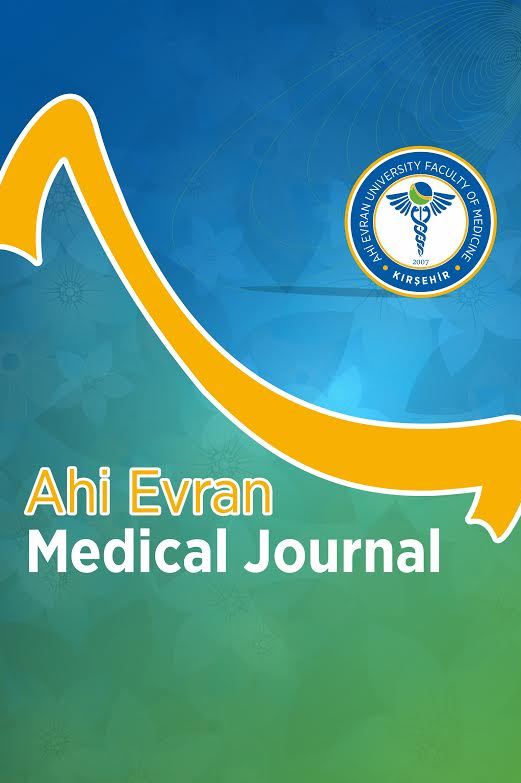Sağlıklı Bireylerde İki Farklı Optik Koherens Tomografi Anjiografi Cihazının Karşılaştırılması
Koryokapillaris, optik koherens tomografi anjiografi, retina, retina
A Comparison of Two Different Optical Coherence Tomography Angiography Devices in Healthy Eyes
choriocapillaris, optical coherence tomography angiography retina, retina, retina, retina,
___
- 1. De Carlo TE, Romano A, Waheed NK, Duker JS. A review of opticalcoherence tomography angiography (OCTA). Int J Retin Vitr. 2015;1(5):1-15.
- 2. Chalam K, Sambhav K. Optical coherence tomography angiography in retinal diseases. J Ophthalmic Vis Res. 2016;11(1):84‑92.
- 3. Falavarjani KG, Sarraf D. Optical coherence tomography angiography of the retina and choroid; current applications and future directions. J Current Ophthalmol. 2017;29(1):1-4.
- 4. Stanga PE, Tsamis E, Papayannis A, Stringa F, Cole T, Jalil A. Swept-Source Optical Coherence Tomography Angio™ (Topcon Corp, Japan): Technology Review. Dev Ophthalmol. 2016;56:13-17.
- 5. Huang D, Jia Y, Gao SS, Lumbroso B, Rispoli M. Optical Coherence Tomography Angiography Using the Optovue Device. Dev Ophthalmol. 2016;56:6-12.
- 6. Kee AR, Yip VCH, Tay ELT, et al. Comparison of two different optical coherence tomography angiography devices in detecting healthy versus glaucomatous eyes- an observational cross-sectional study. BMC Ophthalmol. 2020;20(1):1-16.
- 7. Yu L, Chen Z. Doppler variance imaging for three-dimensional retina and choroid angiography. J Biomed Opt 2010;15(1):016029.
- 8. Makita S, Jaillon F, Yamanari M, et al. Comprehensive in vivo micro-vascular imaging of the human eye by dualbeam-scan Doppler optical coherence angiography. Opt Express. 2011;19(2):1271-1283.
- 9. Spaide RF, Fujimoto JG, Waheed NK, Sadda SR, Staurenghi G. Optical coherence tomography angiography. Prog Retin Eye Res. 2018;64:1-55.
- 10. Hagag AM, Gao SS, Jia Y, Huang D. Optical coherence tomography angiography: Technical principles and clinical applications in ophthalmology. Taiwan J Ophthalmol. 2017;7(3):115-129.
- 11. Li XX, Wu W, Zhou H, et al. A quantitative comparison of five optical coherence tomography angiography systems in clinical performance. Int J Ophthalmol. 2018;11(11):1784-1795.
- 12. Lu Y, Wang JC, Cui Y, et al. A quantitative comparison of four optical coherence tomography angiography devices in healthy eyes. Graefes Arch Clin Exp Ophthalmol. (2020) doi: 10.1007/s00417-020-04945-9.
- 13. Corvi F, Pellegrini M, Erba S, Cozzi M, Staurenghi G, Giani A. Reproducibility of vessel density, fractal dimension and foveal avascular zone using 7 different optical coherence tomography angiography devices. Am J Ophthalmol. 2018;186:25-31.
- Yayın Aralığı: Yılda 3 Sayı
- Başlangıç: 2017
- Yayıncı: Kırşehir Ahi Evran Üniversitesi
Sağlıklı Bireylerde İki Farklı Optik Koherens Tomografi Anjiografi Cihazının Karşılaştırılması
Sebile ÇOMÇALI, Cemal ÇAVDARLI, Mehmet Numan ALP
Sercan ÖZKAÇMAZ, İlyas DÜNDAR, Nazım KANKILIÇ, Mesut ÖZGÖKÇE, Abdullah GÜL, Rahmi ASLAN
Asemptomatik Safra Taşlarında Kolesistektomi Sıklığı ve İlişkili Faktörlerin Araştırılması
Ali KIRIK, Ali Cem YEKDEŞ, Uğur ERGÜN, Burak ALP, Merve Nur AK, Teoman DOĞRU
Dahiliye Polikliniğine Başvuran Bir Grup Hastanın Depresyon ve Somatizasyon Düzeylerinin İncelenmesi
Doğum Şeklinin Umbilikal Kord Kanındaki Tiyol-Disulfid Dengesine Etkisi
Selda SONGUR DAĞLI, Recai DAĞLI
Tekrarlayan Gebelik Kayıplı Hastalarda Kromozom Analizinin Yeri
Burhan BALTA, Murat ERDOĞAN, Aslıhan KİRAZ, Zeki YILMAZ
Laparoskopik Sleeve Gastrektomi Sonrası Morbid Obez Hastalarda Akdeniz Diyetinin Etkinliği
Mehmet Nuri KOŞAR, Umut R. GÜNDÜZ, Onur İlkay DİNÇER, Tuğrul ÇAKIR
Nd:YAG Lazer Onikomikoz Tedavisinde Etkili midir?
Serkan DÜZAYAK, Orhan ÖZGÖZTAŞI
Adenotonsiller Hipertrofinin Neden Olduğu Pediatrik OSAS’ın Koroid Kalınlığı Üzerine Etkisi
Postoperatif Pulmoner Komplikasyonların Öngörülmesinde Belirteç Karşılaştırılması; Asa ve Ariscat
